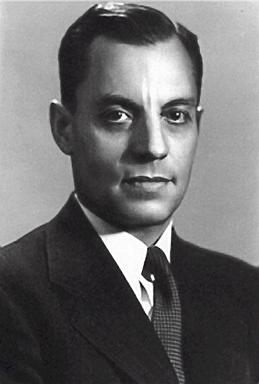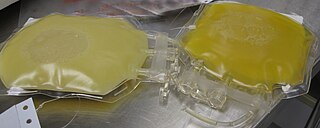Related Research Articles

In nutrition,biology,and chemistry,fat usually means any ester of fatty acids,or a mixture of such compounds,most commonly those that occur in living beings or in food.
High-density lipoprotein(HDL) is one of the five major groups of lipoproteins. Lipoproteins are complex particles composed of multiple proteins which transport all fat molecules (lipids) around the body within the water outside cells. They are typically composed of 80–100 proteins per particle. HDL particles enlarge while circulating in the blood,aggregating more fat molecules and transporting up to hundreds of fat molecules per particle.

Atherosclerosis is a pattern of the disease arteriosclerosis,characterized by development of abnormalities called lesions in walls of arteries. This is a chronic inflammatory disease involving many different cell types and driven by elevated levels of cholesterol in the blood. These lesions may lead to narrowing of the arterial walls due to buildup of atheromatous plaques. At the onset there are usually no symptoms,but if they develop,symptoms generally begin around middle age. In severe cases,it can result in coronary artery disease,stroke,peripheral artery disease,or kidney disorders,depending on which body part(s) the affected arteries are located in the body.

Ancel Benjamin Keys was an American physiologist who studied the influence of diet on health. In particular,he hypothesized that replacing dietary saturated fat with polyunsaturated fat reduced cardiovascular diseases. Modern dietary recommendations by health organizations,systematic reviews,and national health agencies corroborate this.
A saturated fat is a type of fat in which the fatty acid chains have all single bonds between the carbon atoms. A fat known as a glyceride is made of two kinds of smaller molecules:a short glycerol backbone and fatty acids that each contain a long linear or branched chain of carbon (C) atoms. Along the chain,some carbon atoms are linked by single bonds (-C-C-) and others are linked by double bonds (-C=C-). A double bond along the carbon chain can react with a pair of hydrogen atoms to change into a single -C-C- bond,with each H atom now bonded to one of the two C atoms. Glyceride fats without any carbon chain double bonds are called saturated because they are "saturated with" hydrogen atoms,having no double bonds available to react with more hydrogen.

The French paradox is an apparently paradoxical epidemiological observation that French people have a relatively low incidence of coronary heart disease (CHD),while having a diet relatively rich in saturated fats,in apparent contradiction to the widely held belief that the high consumption of such fats is a risk factor for CHD. The paradox is that if the thesis linking saturated fats to CHD is valid,the French ought to have a higher rate of CHD than comparable countries where the per capita consumption of such fats is lower.

The Mediterranean diet is a concept first invented in 1975 by the American biologist Ancel Keys and chemist Margaret Keys. The diet took inspiration from the eating habits and traditional food typical of Crete,much of the rest of Greece,and southern Italy,and formulated in the early 1960s. It is distinct from Mediterranean cuisine,which covers the actual cuisines of the Mediterranean countries,and from the Atlantic diet of northwestern Spain and Portugal. While inspired by a specific time and place,the "Mediterranean diet" was later refined based on the results of multiple scientific studies.

Cardiovascular disease (CVD) is any disease involving the heart or blood vessels. CVDs constitute a class of diseases that includes:coronary artery diseases,heart failure,hypertensive heart disease,rheumatic heart disease,cardiomyopathy,arrhythmia,congenital heart disease,valvular heart disease,carditis,aortic aneurysms,peripheral artery disease,thromboembolic disease,and venous thrombosis.

Hypercholesterolemia,also called high cholesterol,is the presence of high levels of cholesterol in the blood. It is a form of hyperlipidemia,hyperlipoproteinemia,and dyslipidemia.

Stanol esters is a heterogeneous group of chemical compounds known to reduce the level of low-density lipoprotein (LDL) cholesterol in blood when ingested,though to a much lesser degree than prescription drugs such as statins. The starting material is phytosterols from plants. These are first hydrogenated to give a plant stanol which is then esterified with a mixture of fatty acids also derived from plants. Plant stanol esters are found naturally occurring in small quantities in fruits,vegetables,nuts,seeds,cereals,legumes,and vegetable oils.

Phytosterols are phytosteroids,similar to cholesterol,that serve as structural components of biological membranes of plants. They encompass plant sterols and stanols. More than 250 sterols and related compounds have been identified. Free phytosterols extracted from oils are insoluble in water,relatively insoluble in oil,and soluble in alcohols.
The lipid hypothesis is a medical theory postulating a link between blood cholesterol levels and the occurrence of cardiovascular disease. A summary from 1976 described it as:"measures used to lower the plasma lipids in patients with hyperlipidemia will lead to reductions in new events of coronary heart disease". It states,more concisely,that "decreasing blood cholesterol [...] significantly reduces coronary heart disease".
The Dietary Approaches to Stop Hypertension or the DASH diet is a diet to control hypertension promoted by the U.S.-based National Heart,Lung,and Blood Institute,part of the National Institutes of Health (NIH),an agency of the United States Department of Health and Human Services. The DASH diet is rich in fruits,vegetables,whole grains,and low-fat dairy foods. It includes meat,fish,poultry,nuts,and beans,and is limited in sugar-sweetened foods and beverages,red meat,and added fats. In addition to its effect on blood pressure,it is designed to be a well-balanced approach to eating for the general public. DASH is recommended by the United States Department of Agriculture (USDA) as a healthy eating plan. The DASH diet is one of three healthy diets recommended in the 2015–20 U.S. Dietary Guidelines,which also include the Mediterranean diet and a vegetarian diet. The American Heart Association (AHA) considers the DASH diet "specific and well-documented across age,sex and ethnically diverse groups."

Mary Gertrude Enig was a nutritionist and researcher known for her unconventional positions on the role saturated fats play in diet and health. She disputed the medical consensus that diets high in saturated fats contribute to development of heart disease,while she advocated for a low-carbohydrate high-fat diet,rich in animal fats and coconut oil.
The chronic endothelial injury hypothesis is one of two major mechanisms postulated to explain the underlying cause of atherosclerosis and coronary heart disease (CHD),the other being the lipid hypothesis. Although an ongoing debate involving connection between dietary lipids and CHD sometimes portrays the two hypotheses as being opposed,they are in no way mutually exclusive. Moreover,since the discovery of the role of LDL cholesterol (LDL-C) in the pathogenesis of atherosclerosis,the two hypotheses have become tightly linked by a number of molecular and cellular processes.

David Mark Hegsted was an American nutritionist who studied the connections between food consumption and heart disease. His work included studies that showed that consumption of saturated fats led to increases in cholesterol,leading to the development of dietary guidelines intended to help Americans achieve better health through improved food choices.
Ronald M. Krauss is an American professor of pediatrics,medical researcher and low-carbohydrate diet advocate. He studies genetic,dietary,and hormonal effects on plasma lipoproteins and coronary disease risk.

The Seven Countries Study is an epidemiological longitudinal study directed by Ancel Keys at what is today the University of Minnesota Laboratory of Physiological Hygiene &Exercise Science (LPHES). Begun in 1956 with a yearly grant of US$200,000 from the U.S. Public Health Service,the study was first published in 1978 and then followed up on its subjects every five years thereafter.

Trans fat,also called trans-unsaturated fatty acids,or trans fatty acids,is a type of unsaturated fat that occurs in foods. Small amounts of trans fats occur naturally,but large amounts are found in some processed foods. Since consumption of trans fats is unhealthy,artificial trans fats are highly regulated or banned in many nations. However,they are still widely consumed in developing nations,resulting in hundreds of thousands of deaths each year. The World Health Organization (WHO) had set a goal to make the world free from industrially produced trans fat by the end of 2023. The goal was not met,and the WHO announced another goal "for accelerated action till 2025 to complete this effort" along with associated support on 1 February 2024.
William Peter Castelli is an American physician,epidemiologist and former director of the Framingham Heart Study.
References
- 1 2 3 "George V Mann (1917-2013)".
- ↑ Coronary heart disease. Janus. 1993. ISBN 978-1-85756-072-5.
- ↑ Burns, Frances (December 14, 1954). "Who Too Much Food Shorten Our Lives". The Boston Globe. p. 44.
- ↑ Rolfe, Lionel (December 10, 1975). "Why Are Some of Us So Fat?". Newsday. p. 61.
- ↑ Maddox, Gaynor (March 23, 1970). "Diet, Exercise are Important in Heart Health Regimen". Muskegon Chronicle. p. 22.
- 1 2 3 "Diet-heart: end of an era".
- 1 2 "What is the Seven Countries Study?".
- ↑ YERUSHALMY J; HILLEBOE HE (1957). "Fat in the diet and mortality from heart disease; a methodologic note". New York State Journal of Medicine. 57 (14): 2343–2354. PMID 13441073.
- ↑ MANN GV (May 1955). "Lack of Effect of a High Fat Intake on Serum Lipid Levels". The American Journal of Clinical Nutrition. 3 (3): 230–233. doi:10.1093/ajcn/3.3.230. PMID 14376359.
- ↑ Keys, Ancel (1956). "The Claim of "Lack of Effect of High Fat Intake on Serum Lipid Levels"". The American Journal of Clinical Nutrition. 4: 74–76. doi:10.1093/ajcn/4.1.74.
- ↑ Mann, George V. (1957). "The epidemiology of coronary heart disease". The American Journal of Medicine. 23 (3): 463–480. doi:10.1016/0002-9343(57)90325-X. PMID 13458210.
- 1 2 Teicholz, N. (2023). "A short history of saturated fat: the making and unmaking of a scientific consensus". Current Opinion in Endocrinology, Diabetes, and Obesity. 30 (1): 65–71. doi:10.1097/MED.0000000000000791. PMC 9794145 . PMID 36477384.
- ↑ Castelli, W. P. (1992). "Concerning the possibility of a nut". Archives of Internal Medicine. 152 (7): 1371–1372. doi:10.1001/archinte.1992.00400190013003. PMID 1303626.
- ↑ "Medicine: The Fat of the Land". 13 January 1961.
- ↑ MANN GV; MUNOZ JA; SCRIMSHAW NS (1955). "The serum lipoprotein and cholesterol concentrations of the Central and North Americans with different dietary habits". The American Journal of Medicine. 19 (1): 25–32. doi:10.1016/0002-9343(55)90271-0. PMID 14388026.
- ↑ Mann, George V.; Roels, Oswald A.; Price, Donald L.; Merrill, Joseph M. (April 1962). "Cardiovascular disease in African Pygmies: A survey of the health status, serum lipids and diet of Pygmies in Congo". Journal of Chronic Diseases. 15 (4): 341–371. doi:10.1016/0021-9681(62)90082-6. PMID 14469320.
- ↑ "The Health and Nutritional Status of Alaskan Eskimos: A Survey of the Interdepartmental Committee on Nutrition for National Defense—1958". The American Journal of Clinical Nutrition. 11 (1): 31–76. July 1962. doi:10.1093/ajcn/11.1.31.
- ↑ Biss, Kurt; Ho, Kang-Jey; Mikkelson, Belma; Lewis, Lena; Taylor, C. Bruce (1971). "Some Unique Biologic Characteristics of the Masai of East Africa". New England Journal of Medicine. 284 (13): 694–699. doi:10.1056/NEJM197104012841304. PMID 5107799.
- ↑ Mann, G. V. (1978). "The Masai, milk and the yogurt factor: an alternative explanation". Atherosclerosis. 29 (2): 265. doi:10.1016/0021-9150(78)90014-x. PMID 646854.
- ↑ Mann, George V.; Garrett, H. Leon; Farhi, Asher; Murray, Henry; Billings, F. Tremaine (January 1969). "Exercise to prevent coronary heart disease: An experimental study of the effects of training on risk factors for coronary disease in men". The American Journal of Medicine. 46 (1): 12–27. doi:10.1016/0002-9343(69)90054-0. PMID 4951420.
- ↑ Hursh, Laurence (November 18, 1970). "Doctor in the Kitchen". The Tipton Daily Tribune. p. 3.
- ↑ "The Care and Feeding of Athletes".
- ↑ "Dr. George Mann Says Low Cholesterol Diets Are Useless, but the 'Heart Mafia' Disagrees".
- 1 2 3 Olszewski, T. M. (2015). "The causal conundrum: the diet-heart debates and the management of uncertainty in American medicine". Journal of the History of Medicine and Allied Sciences. 70 (2): 218–249. doi:10.1093/jhmas/jru001. PMID 24599909.
- ↑ "Coronary heart disease. The dietary sense and nonsense. An evaluation by scientists". Family Practice. 11 (2): 222–223. June 1994. doi:10.1093/fampra/11.2.222.
- ↑ Taubes, Gary (2001). "The Soft Science of Dietary Fat". Science. 291 (5513): 2536–2545. doi:10.1126/science.291.5513.2536. PMID 11286266.
- ↑ Taubes, Gary (7 July 2002). "What if It's All Been a Big Fat Lie?". The New York Times.
- ↑ "The Big Fat Surprise: Why Butter, Meat and Cheese Belong in a Healthy Diet, by Nina Teicholz. Reviewed by DJ McNamara".